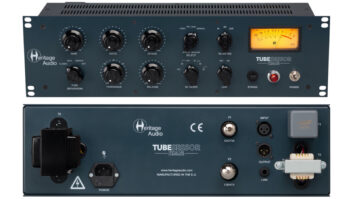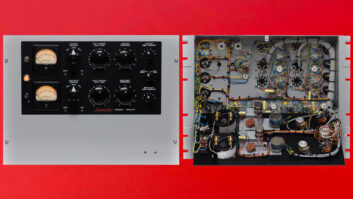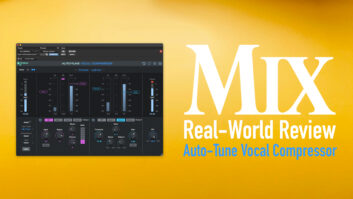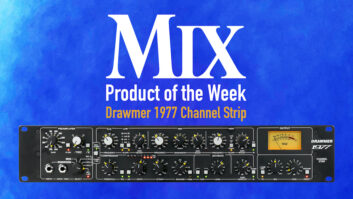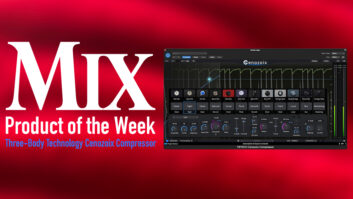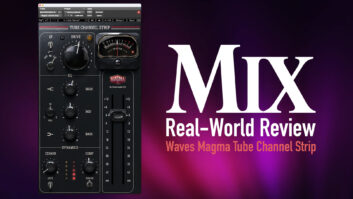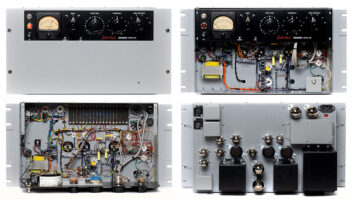
For years, multiband compressors have been the strict purview of mastering and broadcast engineers. They’ve seldom found use in music recording studios because of their inherent complexity and the potential for catastrophe if incorrectly set.
First in Ivor Drawmer’s Signature Series, the $6,995 S3 3-band compressor, reinvents the arcane multiband process using 10 tubes and three identical Class-A, fully balanced stereo signal paths. The S3 is easy to use, and it achieves a depth of precision in spectral dynamic control that is not possible with a single-band compressor.
IMPRESSIVE OUTSIDE AND IN
A pair of large, backlit VU meters and stylish engraved borders around each processor section dominate the beautiful black gloss of the three-rackspace front panel. High-contrast white lettering, Ivor Drawmer’s signature and an intuitive layout complete the look of this future classic.
Inside the well-vented cabinet, eight 12AX7s and two 12BH7s (secured by wire clamps) surround a large toroidal power transformer. All components, including the custom-made Stevens and Billington I/O transformers, are mounted on a thick PC board. The S3 generates considerable heat so keep an air space around it in your rack. All of the S3’s Omeg conductive plastic pots have a nice, damped feeling to them — no need to worry about settings changing if someone accidentally brushes up against them.
At the heart of the S3 are three optical light-dependent resistor elements (LDRs) for both left and right channel — six total. To optimize compressor tracking performance, the LDRs must behave identically and therefore are encased in two small ovens (one for each channel), running at 50 degrees centigrade. About two minutes after power-up, a front panel indicator shows the LDRs have reached operating temperature.
THREE OF EVERYTHING
The multiband compression process starts with stereo audio being divided into three frequency bands — high, mid and low — using two gentle 6dB/octave passive filters. The Low-Split control sets the frequency (60 to 1.4k Hz) where the audio is divided between the low and mid-band, while the High-Split knob (1.4 to 14 kHz) sets the mid/high-band dividing point. Once separated, each band’s audio output is routed to its own stereo compressor section.
The controls for each band are identical and include separate threshold, attack time, release time and make-up gain. The three make-up gain controls also function as a 3-channel stereo mixer to recombine each of the bands’ audio output back into a composite stereo audio signal.
Each band’s threshold is adjustable from infinity (off) to -32 dB, and an 8-segment LED meter indicates gain reduction for each band. Attack time choices are 0.2/ 2/5/10/20/50 ms; release times are 80/300/1,000 ms. There are also three program-dependent release times: fast (100 to 500 ms), medium (300 ms to 2 seconds) and slow (500 ms to 5 seconds). The program-dependent compression ratio increases with input level. The 1.05:1 starting ratio is very low; the highest ratio possible at a maximum gain reduction of more than 20 dB for each band section is about 5:1.
Three bypass switches let you A/B each compressor’s effect to the overall sound. For example, you can compress only the low band — i.e., for recording bass guitar — or compress a vocal solely in the mid- and low bands, leaving the high band open and uncompressed. Additionally, three Normal/Mute switches can add/subtract a band section’s contribution to the stereo output to audition each band separately or in combination.
BIG AIR
The Big switch on the low-band compressor inserts a passive 100Hz, 6dB/octave shelving filter into the compressor side-chain. Engaging Big results in less pumping in the bass when loud percussive LF events such as kick drums or vocal “p” plosives are present in your program. On the high-band compressor, an Air switch places a 12kHz peaking filter into the sidechain, keeping high frequencies more open under heavy gain reduction.
A master gain control on the output section sets the final stereo output level. A balance control compensates for any level differences between the left/right channels. Meters are input/output-switchable, and a range Pad switch decreases the VU meter’s sensitivity by 10 or 20 dB.
THREE-WAY CRUNCH
I used the S3 for live recording and simple mastering projects. On a broadband sound source like a drum kit, the S3 is a wonderful processor for room mics. I had a pair of AKG C 12s left and right, 10 feet in front of the drum kit at about five feet off the floor. The initial settings for all three bands were -10dB threshold, 0.2ms attack and 0.3 release; crossovers at 4kHz and 500Hz positions; and Big and Air on. Most of the gain reduction occurred in the mid- and low-band sections. Compressing and changing the level relationship between each of the three bands lets you “sculpt” — reshape the sonic characteristics of your drum room and the overall drum sound.
One track required a very midrange-y snare and kick drum sound similar to Cameo or early Prince records, so I squashed the mids to about -8 dB of gain reduction and raised its level above the other bands. I bypassed the high-band section and only minimally compressed the low band. Anyway I set it, the S3’s overall sound quality was exceptionally clear and clean.
On another session, the artist wanted a big rock drum sound where you could hear the compressor pump on cymbal crashes when doubled with kick drum hits. With Big switched off, I compressed to about -6 dB of gain reduction and elevated the low band, reduced the mid-band’s level with 2 dB of gain reduction and compressed the high band starting at 5 kHz. This caused the bass drum to sound huge, like it sounded in the studio — just what the artist wanted.
In a mastering application, I used the S3 to repurpose old 2-track tape masters for song publishing demos. Here, the band-splitting ranges of 2 to 4 kHz for the high band and 250 to 500 Hz for the low band worked best. I changed the crossover points on a song-by-song basis — mostly depending on the production style, vocal level and instrumentation makeup. I increased loudness by compressing the missing high- and low-frequency ranges in these old tapes and reducing some of the midrange buildup. Using the S3 as a kind of “power EQ,” the tapes sounded more vibrant, alive and louder.
By setting the high-band split to 10 kHz (or higher) and the threshold to -32 dB on the high-band compressor with the fastest attack and release times, I got a gentle de-essing action that didn’t dull the desirable high frequencies. Leaving the Air switch off, I set the low-band split controls to 60 Hz, so it and the mid-band section acted as full-bandwidth compressors for the rest of the mix.
POWERFUL ANALOG PROCESSING
The S3 is easy and intuitive to use and lets you set up multiband compression without resorting to trial-and-error and constant tweaking. I’ve used other models and many software plug-in processors, but none were as simple to use and absolutely gorgeous-sounding as this unit.
Drawmer, dist. by TransAudio Group, 702/365-5155, www.transaudiogroup.com, www.drawmerusa.com.
Barry Rudolph is an L.A.-based recording engineer. Visit him online at
www.barryrudolph.com.
